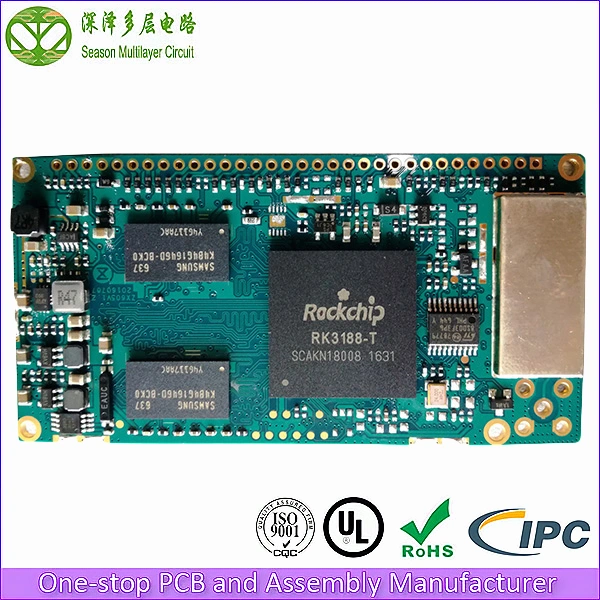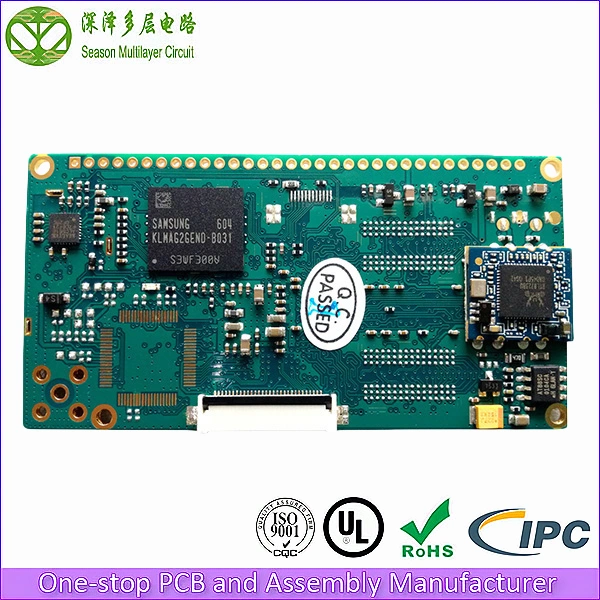Navigation Core Board PCBA

Core Board PCBA
Material: Fr4 Tg170
Board Thickness: 1.6mm
Processing Size(Max): 510*460mm
Processing Size(Min): 50*30mm
Cell Size(Min): 0201
BGA Pitch: 0.35mm
BGA Diameter(Min): 0.18mm
Footprint: SOP、SOT、QFN、QFP、BGA
Automotive navigation core board PCBA, RK3188 solution, used as the core module for automotive navigation systems.


Automotive Navigation Core Board PCBA: The Heart of Modern Vehicle Navigation Systems
Introduction
The automotive navigation core board PCBA (Printed Circuit Board Assembly) is a critical component in modern vehicle navigation systems. It serves as the central processing unit responsible for receiving, interpreting, and relaying navigation signals to ensure accurate positioning and route guidance. As vehicles become increasingly connected and autonomous, the role of the navigation core board continues to evolve, integrating advanced features such as real-time traffic updates, AI-driven path optimization, and seamless connectivity with other smart devices.
This article provides an in-depth exploration of automotive navigation core boards, covering their definition, functionality, internal architecture, applications, future trends, and key considerations for selection and evaluation.
1. Definition and Functionality of Automotive Navigation Core Boards
An automotive navigation core board is an electronic module designed to process GPS (Global Positioning System) signals and facilitate vehicle navigation. It acts as the brain of the navigation system, interfacing with onboard displays, audio systems, and other peripherals to deliver essential functions such as:
- Real-time positioning – Accurately determining the vehicle’s location using satellite signals.
- Route planning – Calculating optimal paths based on destination inputs and traffic conditions.
- Map rendering – Displaying detailed maps with turn-by-turn directions.
- Voice guidance – Providing spoken instructions to enhance driver safety and convenience.
- Connectivity – Enabling communication with external networks for live traffic updates and software upgrades.
Given its pivotal role, the navigation core board must ensure high reliability, low latency, and robust signal processing to meet the demands of modern automotive applications.
2. Composition and Working Principle of Automotive Navigation Core Boards
The navigation core board consists of several key components, each contributing to its overall functionality:
(1) GPS Module
- Receives signals from multiple satellites to determine the vehicle’s precise coordinates.
- Supports multi-constellation systems (e.g., GPS, GLONASS, BeiDou, Galileo) for enhanced accuracy.
(2) Main Control Chip (Processor)
- Typically based on high-performance SoCs (System-on-Chip) like the RK3188 solution, which balances power efficiency and processing capability.
- Executes complex algorithms for position calculation, route optimization, and system control.
(3) Memory Chip
- Stores map data, firmware, and navigation software.
- May include both flash memory (for persistent storage) and RAM (for real-time processing).
(4) Communication Module
- Facilitates data exchange with external networks (4G/5G, V2X, Wi-Fi) for real-time updates.
- Enables integration with cloud-based navigation services and IoT (Internet of Things) platforms.
How It Works
- The GPS module captures satellite signals and converts them into digital data.
- The main control chip processes this data to compute the vehicle’s position, speed, and heading.
- The processed information is stored in the memory chip and relayed to the display and audio systems for user interaction.
- The communication module fetches live traffic data and software updates to enhance navigation accuracy.
3. Applications and Future Trends in Automotive Navigation Core Boards
Current Applications
- In-vehicle navigation systems – Found in passenger cars, commercial trucks, and fleet management solutions.
- Smart transportation – Used in traffic monitoring, emergency response, and autonomous driving systems.
- Logistics and fleet tracking – Enables real-time vehicle tracking for delivery and transportation companies.
Emerging Trends
- AI-enhanced navigation – Machine learning algorithms for predictive routing and adaptive traffic avoidance.
- Autonomous driving integration – Fusion with LiDAR, radar, and camera systems for self-driving capabilities.
- 5G and V2X connectivity – Ultra-low latency communication for real-time road condition updates.
- Energy efficiency improvements – Lower power consumption for electric and hybrid vehicles.
As navigation systems evolve, future core boards will likely incorporate edge computing, augmented reality (AR) displays, and enhanced cybersecurity measures to protect against hacking.
4. Key Considerations for Selecting and Evaluating Navigation Core Boards
When choosing an automotive navigation core board, the following factors must be evaluated:
(1) Performance Metrics
- Positioning accuracy (e.g., <2.5m error in open-sky conditions).
- Signal acquisition speed (time-to-first-fix, or TTFF).
- Multi-path resistance (ability to filter out reflected signals in urban environments).
(2) Compatibility
- Must support standard interfaces (CAN bus, USB, Bluetooth, HDMI) for seamless integration with vehicle systems.
(3) Power Efficiency & Thermal Management
- Low power consumption to minimize battery drain.
- Effective heat dissipation to prevent overheating in prolonged use.
(4) Cost and Scalability
- Competitive pricing for mass-market adoption.
- Modular design for easy upgrades and customization.
Conclusion
The automotive navigation core board PCBA is a fundamental component that powers modern vehicle navigation, enabling precise positioning, intelligent routing, and seamless connectivity. With advancements in AI, 5G, and autonomous driving, these core boards will play an even more critical role in shaping the future of smart mobility.
When selecting a navigation core board, manufacturers and integrators must carefully assess performance, compatibility, power efficiency, and cost to ensure optimal system reliability and user experience. As technology progresses, we can expect navigation systems to become faster, smarter, and more integrated into the broader ecosystem of connected vehicles.
Would you like additional details on any specific aspect of automotive navigation PCBA technology?

